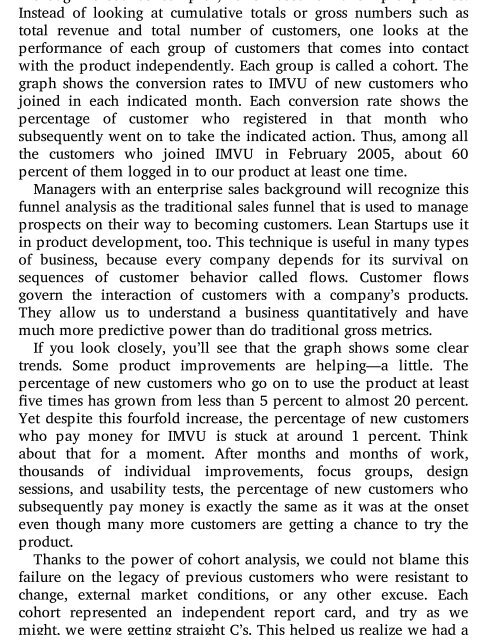Acclaim for THE LEAN STARTUP
The Lean Startup: How Today's Entrepreneurs Use Continuous ...
The Lean Startup: How Today's Entrepreneurs Use Continuous ...
- No tags were found...
Create successful ePaper yourself
Turn your PDF publications into a flip-book with our unique Google optimized e-Paper software.
Although it sounds complex, it is based on a simple premise.<br />
Instead of looking at cumulative totals or gross numbers such as<br />
total revenue and total number of customers, one looks at the<br />
per<strong>for</strong>mance of each group of customers that comes into contact<br />
with the product independently. Each group is called a cohort. The<br />
graph shows the conversion rates to IMVU of new customers who<br />
joined in each indicated month. Each conversion rate shows the<br />
percentage of customer who registered in that month who<br />
subsequently went on to take the indicated action. Thus, among all<br />
the customers who joined IMVU in February 2005, about 60<br />
percent of them logged in to our product at least one time.<br />
Managers with an enterprise sales background will recognize this<br />
funnel analysis as the traditional sales funnel that is used to manage<br />
prospects on their way to becoming customers. Lean Startups use it<br />
in product development, too. This technique is useful in many types<br />
of business, because every company depends <strong>for</strong> its survival on<br />
sequences of customer behavior called ows. Customer ows<br />
govern the interaction of customers with a company’s products.<br />
They allow us to understand a business quantitatively and have<br />
much more predictive power than do traditional gross metrics.<br />
If you look closely, you’ll see that the graph shows some clear<br />
trends. Some product improvements are helping—a little. The<br />
percentage of new customers who go on to use the product at least<br />
ve times has grown from less than 5 percent to almost 20 percent.<br />
Yet despite this fourfold increase, the percentage of new customers<br />
who pay money <strong>for</strong> IMVU is stuck at around 1 percent. Think<br />
about that <strong>for</strong> a moment. After months and months of work,<br />
thousands of individual improvements, focus groups, design<br />
sessions, and usability tests, the percentage of new customers who<br />
subsequently pay money is exactly the same as it was at the onset<br />
even though many more customers are getting a chance to try the<br />
product.<br />
Thanks to the power of cohort analysis, we could not blame this<br />
failure on the legacy of previous customers who were resistant to<br />
change, external market conditions, or any other excuse. Each<br />
cohort represented an independent report card, and try as we<br />
might, we were getting straight C’s. This helped us realize we had a




